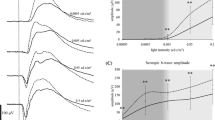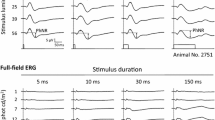Abstract
Dark-adapted and light-adapted electroretinogaphic luninance-response functions were recorded from subjects with light or dark fundus pigmentation based on digitized fundus photographs. For dark- and light-adapted electroretinograms, subjects with dark fundi had smaller b-wave amplitudes at all luminance levels. There was no significant difference in b-wave implicit time for the dark-adapted electroretinogram, but there was a significant difference for the light-adapted ERG between the two groups. The results suggest that fundus pigmentation should be considered in the interpretation of electroretinogram results. A possible mechanism for the influence of fundus pigmentation on b-wave amplitude is based on increased resistance associated with melanin.
Similar content being viewed by others
Abbreviations
- ISI:
-
interstimulus interval
- L-R function:
-
luminance-response function
- ND:
-
neutral density
References
Wali N, Leguire LE. Fundus pigmentation and the dark-adapted electroretinogram. Doc Ophthalmol 1992; 80: 1–11.
Naka KI, Rushton WAH. S-potentials from color units in the retina of fish (Cyprinidae). J Physiol 1966; 185: 536–55.
Wali N, Leguire LE. Dark-adapted luminance-response functions with skin and corneal electrodes. Doc Ophthalmol 1991; 76: 367–75.
Doslak MJ, Plonsey R, Thomas CW. The effects of variations of the conducting media inhomogeneities on the electroretinogram. IEEE Trans Biomed Eng 1980; 27: 88–94.
Steinberg RH, Linsenmeier RA, Griff ER. Retinal pigment epithelial cell contributions to the electroretinogram and electrooculogram. Prog Retinal Res 1985; 4: 33–66.
Rodieck RW. The vertebrate retina. Principles of structure and function. San Francisco: WH Freeman, 1973: 525–36.
Weiter J, Delori FC, Wing GL, Fitch KA. Retinal pigment epithelial lipofuscin and melanin and choroidal melanin in human eyes. Invest Ophthalmol Vis Sci 1986; 27: 145–52.
Faber DS. Analysis of the slow transretinal potentials in response to light. Buffalo, NY: State University of New York, 1969. Dissertation.
McGinness J, Proctor P. Amorphous semiconductor switching in melanins. Science 1974; 183: 853–55.
Pethig R. Electronic properties of biomacromolecules. In: Dielectric and electronic properties of biological materials. New York: John Wiley & Sons, 1979: 343–9.
Filatovs J, McGinness J, Corry P. Thermal and electronic contributions to switching in melanins. Biopolymers 1976; 15: 2309–12.
Wali N, Leguire LE. The photopic hill: A new phenomenon of the light adapted electroretinogram. Doc Ophthalmol 1992; 80: 335–42.
Author information
Authors and Affiliations
Rights and permissions
About this article
Cite this article
Wali, N., Leguire, L.E. Fundus pigmentation and the electroretinographic luminance-response function. Doc Ophthalmol 84, 61–69 (1993). https://doi.org/10.1007/BF01203283
Accepted:
Issue Date:
DOI: https://doi.org/10.1007/BF01203283




